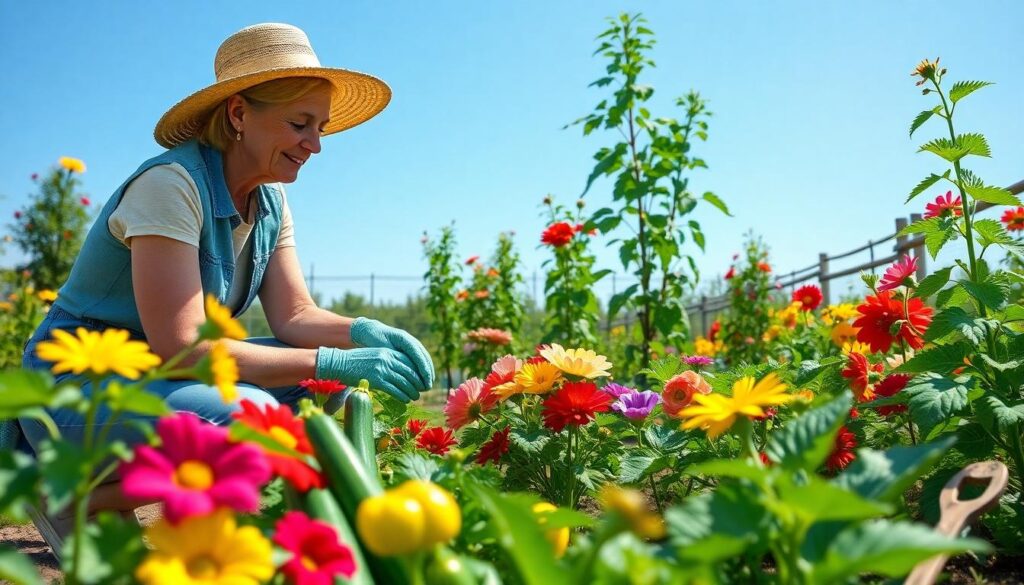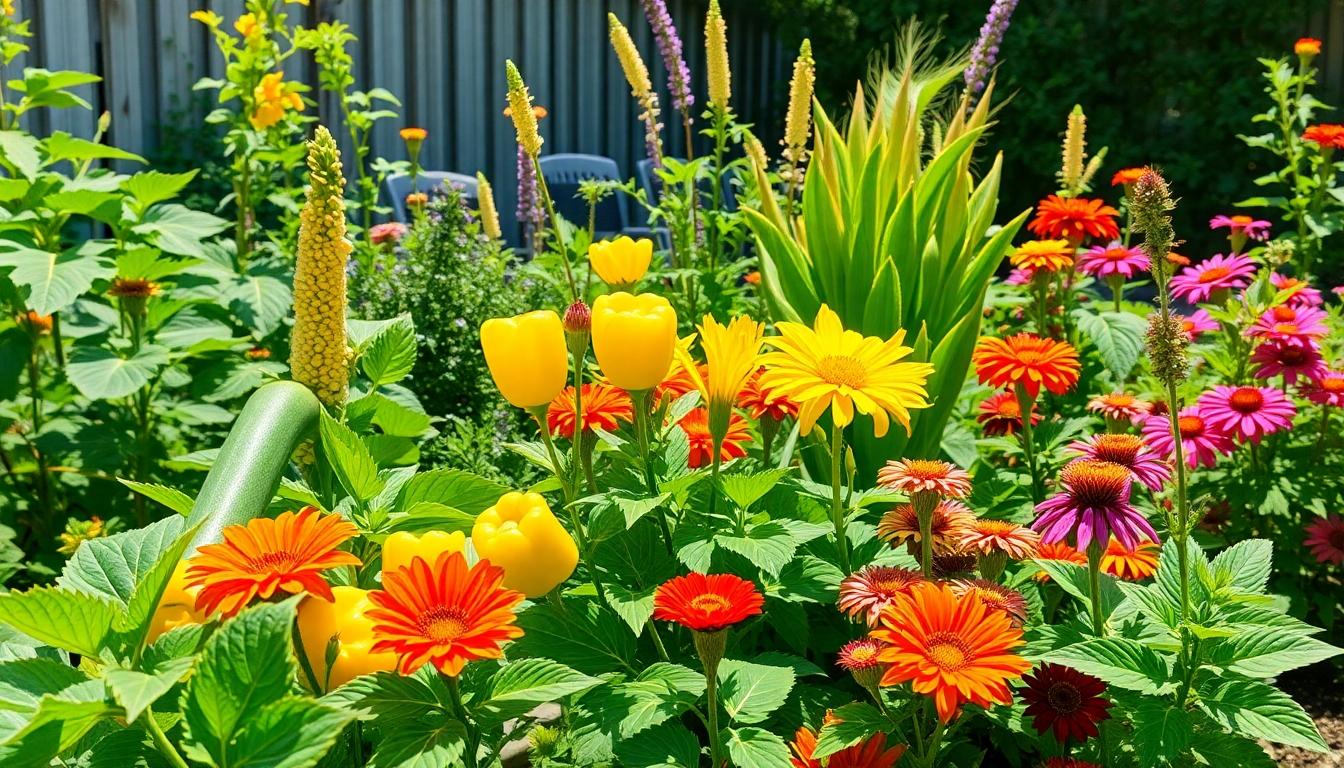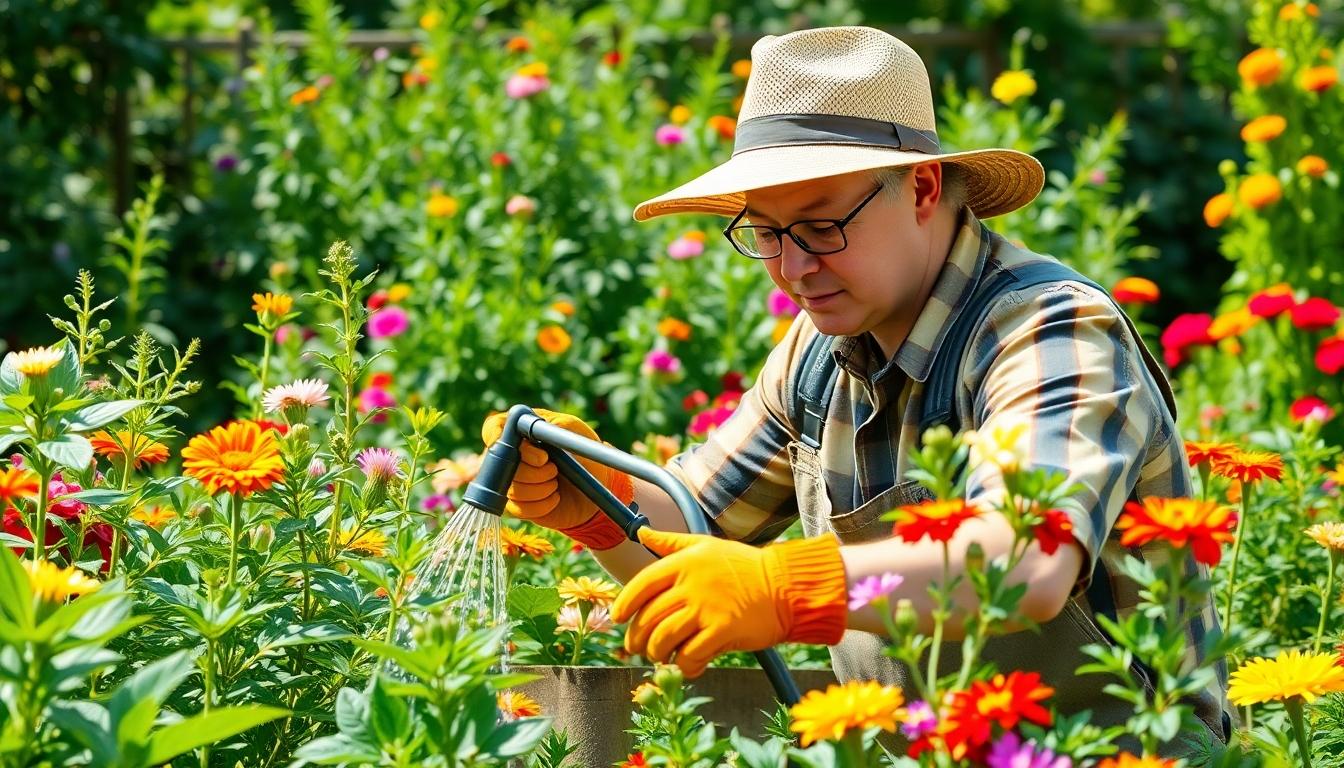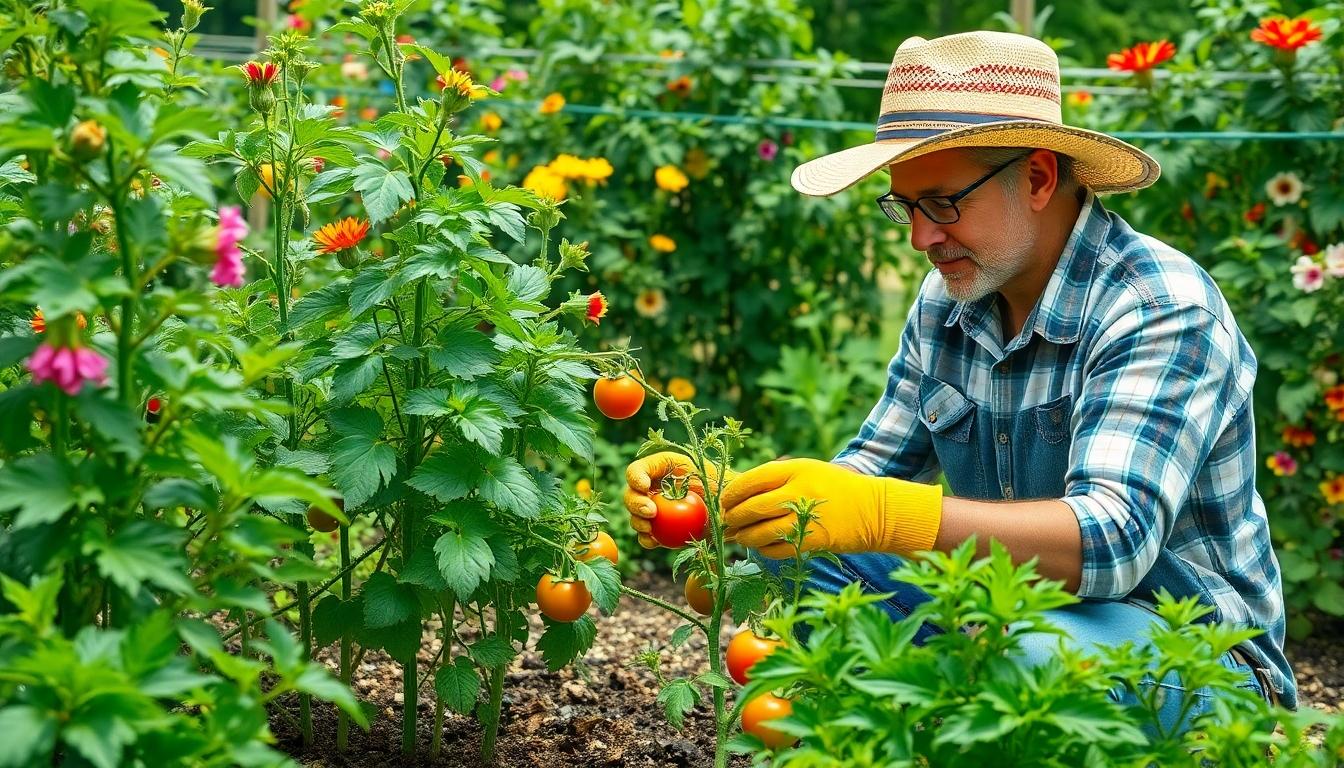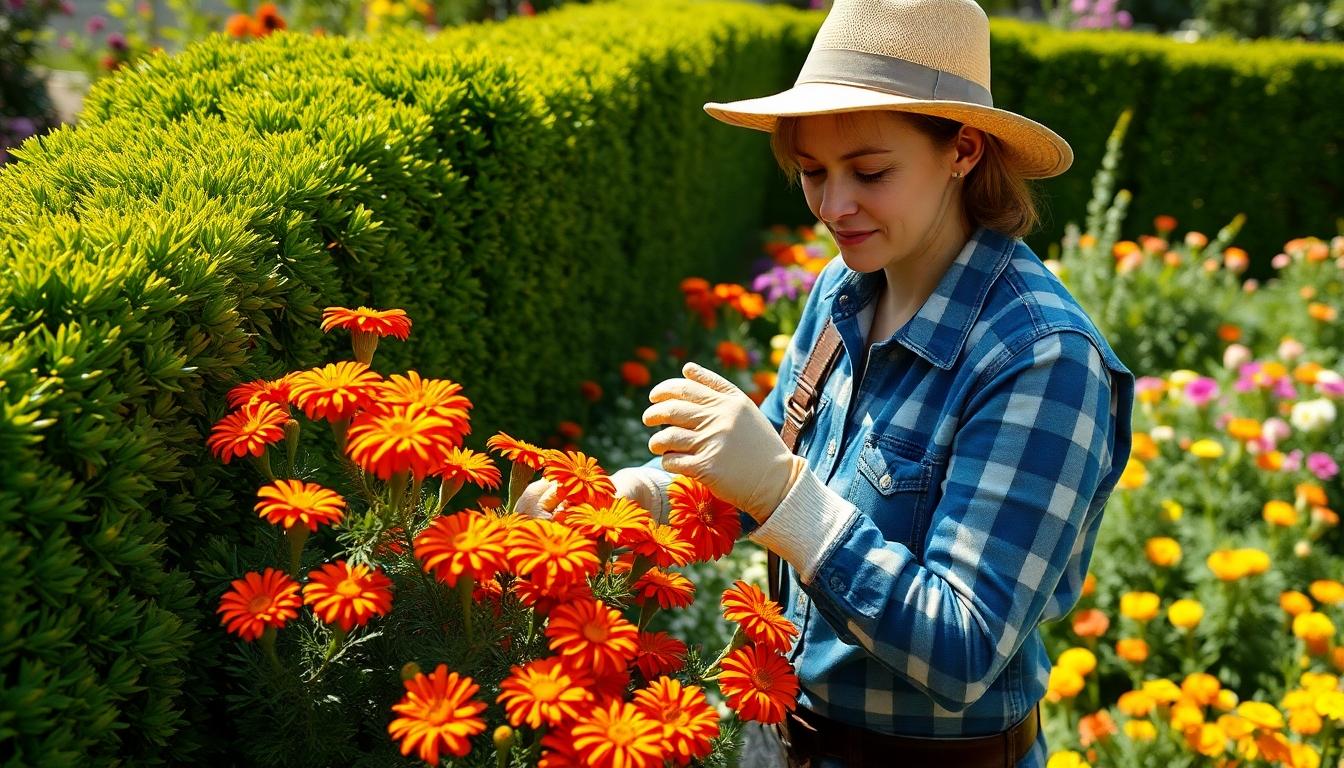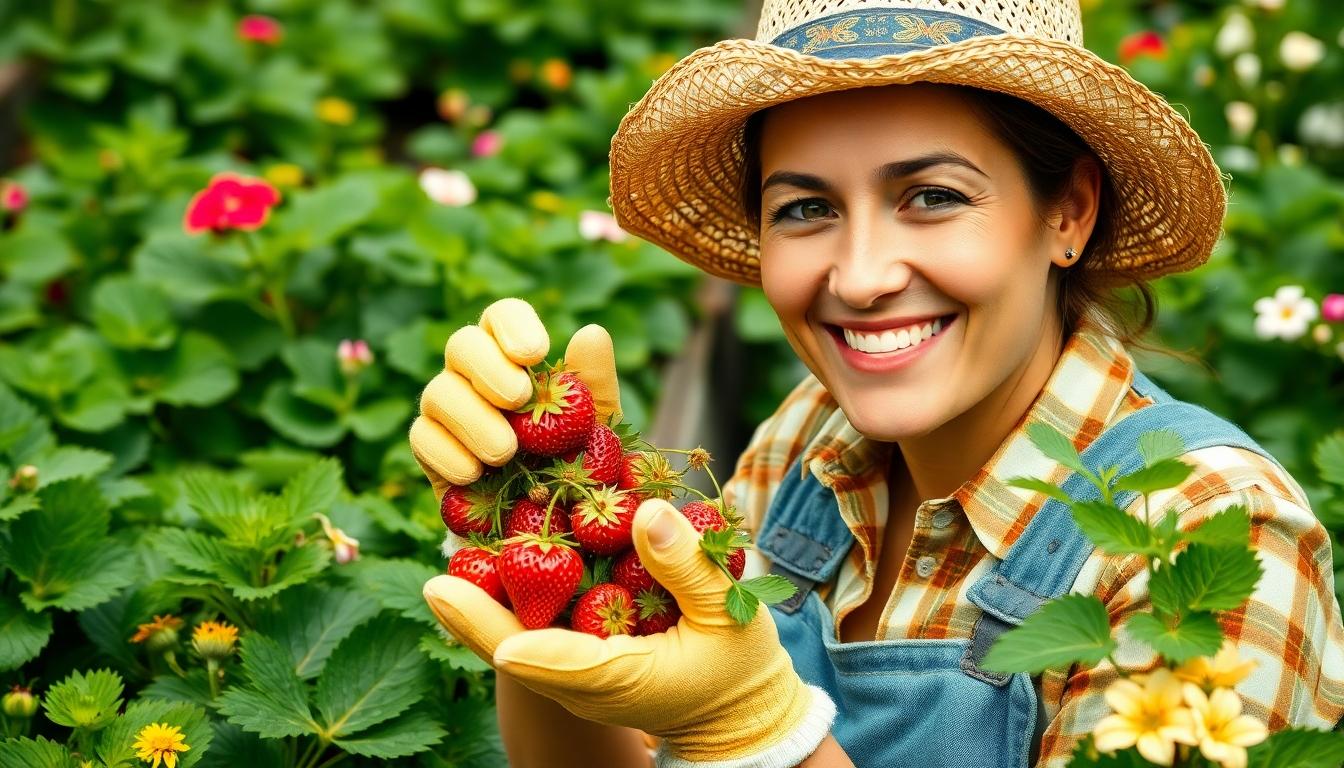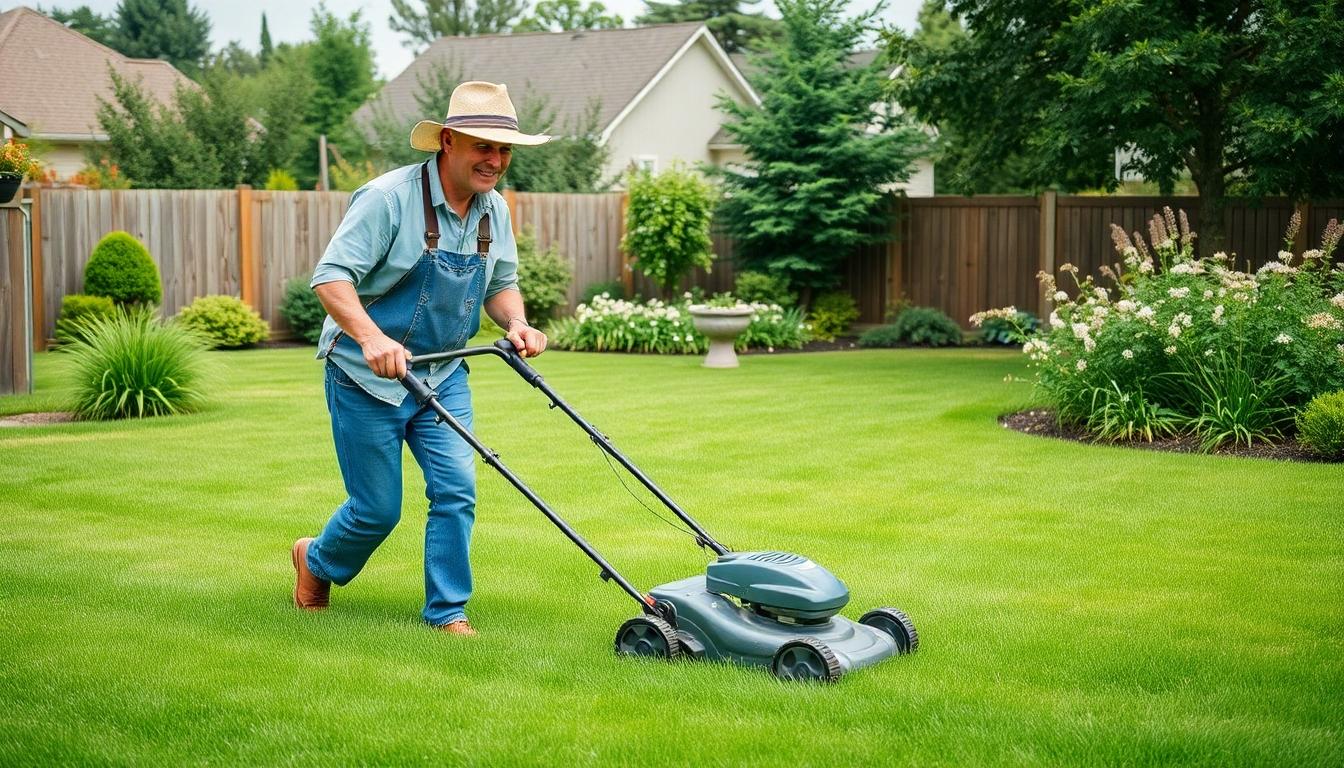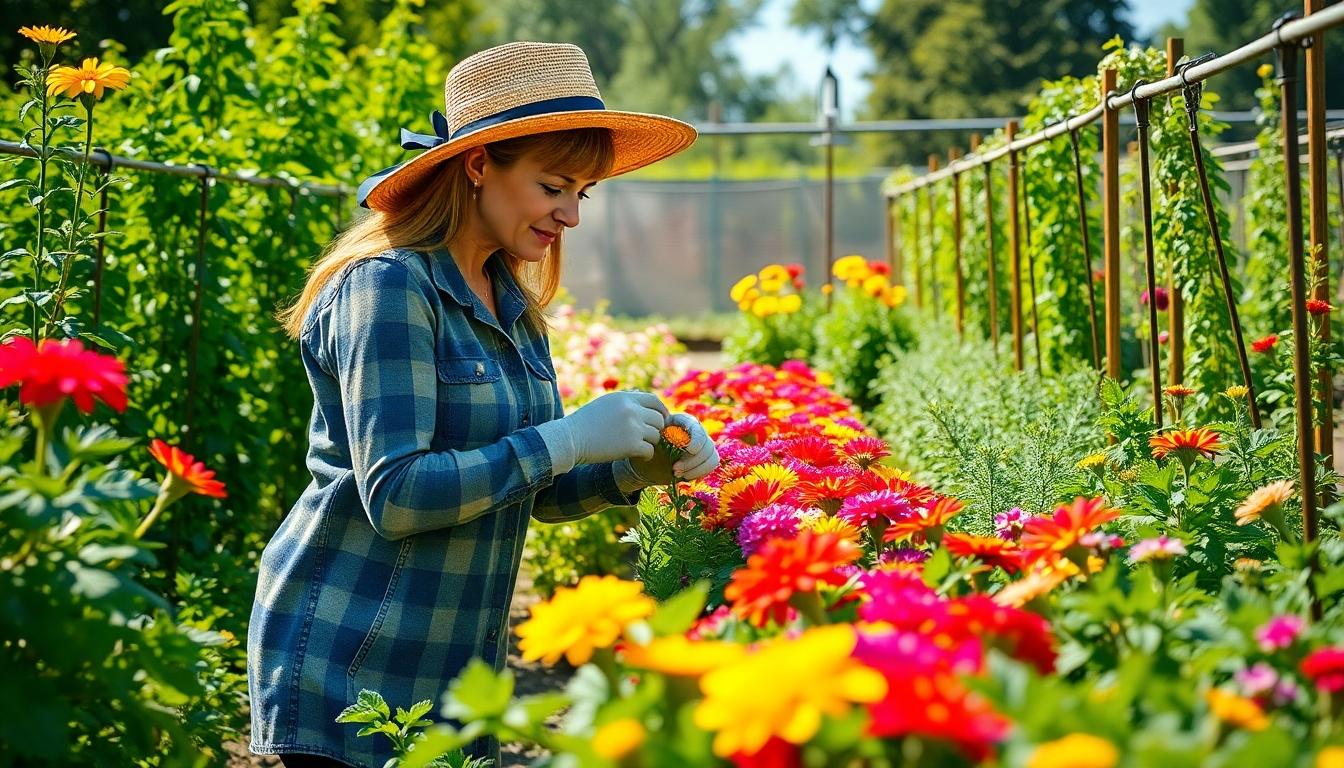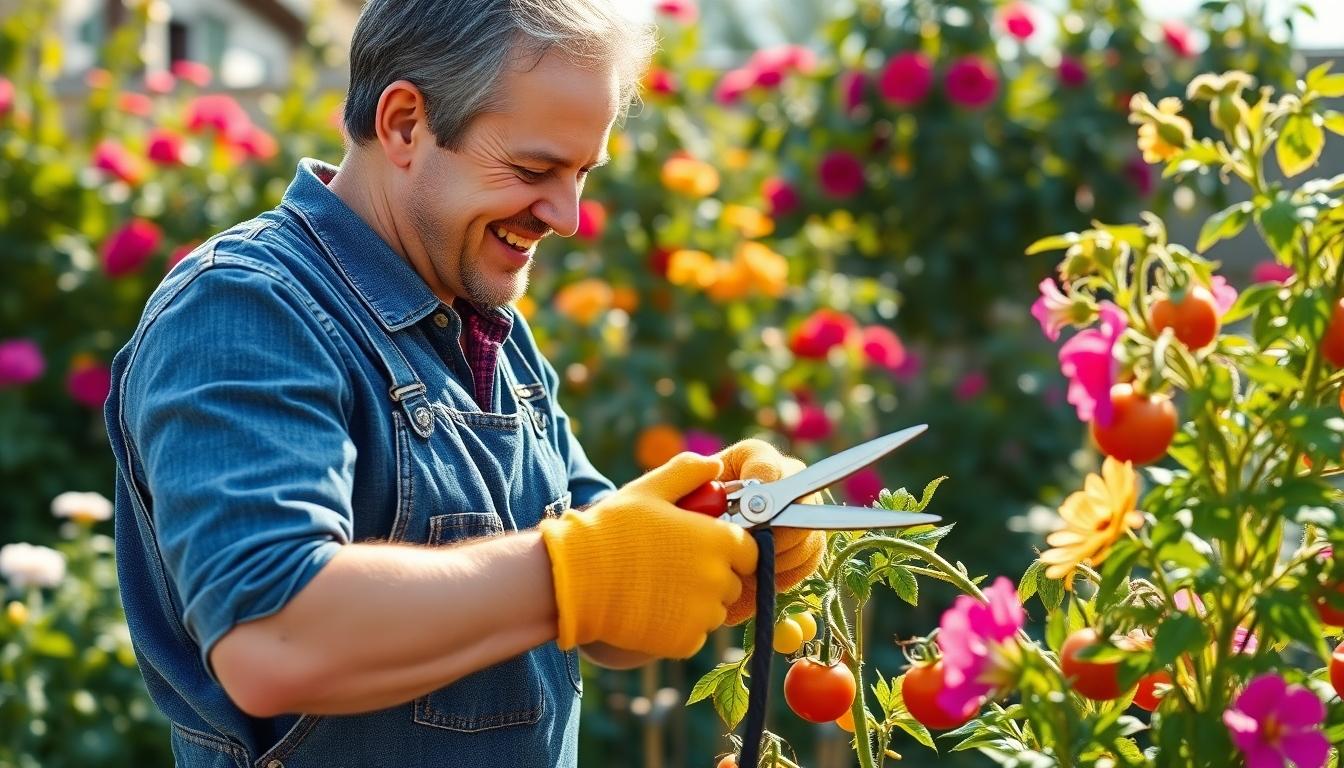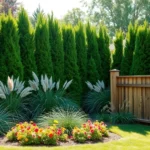June marks the official start of summer gardening season, bringing longer days and warmer temperatures that create perfect conditions for plant growth. We’ve compiled the essential gardening tasks you’ll need to tackle this month to ensure your garden thrives throughout the summer months ahead.
With flowers blooming, vegetables developing, and pests becoming more active, now’s the time to establish regular maintenance routines. From strategic watering and mulching to timely pruning and pest control, these June gardening tasks will help you maximize your garden’s potential. We’ll show you exactly what needs attention now so you can enjoy a bountiful and beautiful garden all season long.
Essential June Gardening Tasks to Keep Your Garden Thriving
1. Establish a Consistent Watering Routine
June’s rising temperatures demand vigilant watering practices to keep your garden flourishing. Plants need more frequent hydration during this warm month, especially newly established ones. Water deeply in the early morning or evening to minimize evaporation and maximize absorption. Most gardens require about 1-1.5 inches of water weekly, but adjust based on your local climate conditions. Container plants may need daily watering as they dry out faster than in-ground plantings.
2. Apply Mulch to Conserve Moisture
Mulching becomes crucial in June when heat starts to intensify. A 2-3 inch layer of organic mulch helps retain soil moisture, suppress weeds, and regulate soil temperature. Materials like shredded bark, compost, or straw work exceptionally well for most garden beds. Keep mulch a few inches away from plant stems and tree trunks to prevent rot and disease issues. Refreshing mulch now will carry your garden through the hottest summer months with minimal stress.
3. Prune Spring-Flowering Shrubs
June is the perfect time to prune spring bloomers like lilacs, forsythia, and rhododendrons. These plants set next year’s flower buds on new growth, so pruning now gives them ample time to develop. Remove dead or crossing branches first, then shape the plant as desired. Avoid removing more than one-third of the plant’s total growth to prevent stress. Sharp, clean pruning tools help make clean cuts that heal quickly and reduce disease risk.
4. Monitor and Control Pests
Pest activity accelerates in June as temperatures climb. Inspect your plants weekly for signs of common summer pests like aphids, Japanese beetles, and tomato hornworms. Introduce beneficial insects such as ladybugs and lacewings as a natural defense system. Neem oil and insecticidal soaps offer effective organic answers for most pest problems. Implementing row covers for vulnerable vegetables provides physical protection without chemicals. Early intervention prevents small pest issues from becoming major infestations.
5. Fertilize Flowering and Fruiting Plants
Many flowering and fruiting plants benefit from a June feeding to support their productive phase. Apply a balanced organic fertilizer to annuals and perennials that are actively blooming. Vegetable gardens appreciate a side dressing of compost or a slow-release organic fertilizer. Avoid high-nitrogen formulations for flowering plants as they promote foliage at the expense of blooms. Container plants need more frequent feeding—typically every 2-3 weeks—as nutrients leach away with regular watering.
6. Deadhead Spent Flowers
Deadheading—removing faded blooms—encourages plants to produce more flowers throughout summer. This simple maintenance task prevents plants from using energy on seed production. Annuals like petunias, marigolds, and zinnias will bloom continuously when deadheaded regularly. Perennials such as coneflowers, black-eyed Susans, and salvias benefit from this practice too. Collect seeds from desirable plants before deadheading if you want to save them for next season.
7. Harvest Early Vegetables and Herbs
June brings the first substantial harvests in many vegetable gardens. Pick early crops like lettuce, spinach, and radishes before they bolt in the heat. Herbs should be harvested in the morning when their essential oils are most concentrated. Regular harvesting encourages continued production in many vegetables like beans, peas, and summer squash. Preserve your harvest through freezing, drying, or canning to enjoy garden-fresh flavors year-round.
8. Plant for Continuous Summer Color
June offers opportunities to add new plants for season-long visual interest. Heat-loving annuals like lantana, zinnia, and portulaca thrive when planted now. Fast-growing vegetables such as beans, cucumbers, and summer squash can still be sown for late summer harvests. Consider adding drought-tolerant perennials like coneflowers, rudbeckia, and yarrow for lasting color with minimal water requirements. Tropical plants and summer bulbs like cannas and dahlias perform exceptionally well when established in June’s warm soil.
Planting and Sowing in the June Garden
June marks a fantastic time to get your hands dirty with many planting opportunities as the soil warms up. Let’s explore what vegetables and flowers thrive when planted during this productive month.
Warm-Weather Vegetables to Plant Now
Now’s the perfect time to focus on heat-loving crops that will flourish throughout summer. Plant sweet corn every other week until early July to ensure a staggered harvest that keeps fresh ears coming to your table for weeks. Summer vegetables like zucchini, bell peppers, and cucumbers can still be planted now for excellent yields later in the season. Consider implementing drip irrigation systems for these thirsty plants to conserve water while maintaining consistent soil moisture. These efficient watering methods deliver hydration directly to root zones, reducing water waste and keeping foliage dry to prevent disease issues.
Best Flowers to Sow in June
June offers multiple opportunities to enhance your garden’s color palette with strategic flower plantings. Annual summer bedding plants work wonderfully in both containers and borders, requiring regular watering for quick establishment and prolific blooming. Create an eye-catching tropical display using dramatic plants like bananas, colorful coleus, and striking amaranthus for an exotic garden feel. Perennials planted now will establish nicely before next year’s growing season, with tall varieties needing support from sturdy canes to prevent flopping when in full bloom. Many summer-flowering perennial varieties can still be planted in June, offering the promise of recurring beauty for years to come while requiring less maintenance than annual plantings.
Watering and Irrigation Strategies for Summer Heat
As June temperatures rise, proper watering becomes critical for garden success. Implementing strategic irrigation practices now will protect your plants through the hottest days ahead while conserving water.
Setting Up Efficient Watering Systems
Drip irrigation and soaker hoses are the gold standard for summer watering, delivering moisture directly to plant roots where it’s needed most while minimizing waste. We recommend installing these systems early in June before extreme heat arrives. Your setup should be thoroughly inspected for leaks and programmed to operate in early mornings when evaporation rates are lowest. Manual waterers should invest in a quality wand nozzle that lets you target the base of plants without wetting foliage, significantly reducing disease risk. Group your plants according to their water requirements—this simple organization can dramatically improve your garden’s water efficiency and prevent both under and overwatering issues.
Mulching to Conserve Moisture
A 2-4 inch layer of organic mulch acts as your garden’s summer shield, creating a protective barrier that locks moisture in while keeping temperatures stable. We find that straw, shredded leaves, and wood chips work exceptionally well for most garden beds. These materials not only conserve moisture but also gradually break down to improve soil quality. Remember to keep mulch from directly touching plant stems to prevent rot issues. Regular mulch replenishment throughout the season maintains this vital moisture barrier during the hottest weeks. Avoid using synthetic mulches as they can actually impede proper water and air flow—something particularly problematic during summer’s intense heat.
For best results, monitor soil moisture by checking 2 inches below the surface with a trowel, watering only when this zone feels dry. Deep watering less frequently encourages stronger root development and drought resilience. Sandy soils will require more frequent attention, while clay soils retain moisture longer and need less frequent watering.
Pest and Disease Control for June Gardens
As summer temperatures rise, so does pest activity in our gardens. June is a critical time to carry out effective pest and disease management strategies to protect your thriving plants.
Common Summer Garden Pests to Watch For
Earwigs become particularly problematic in June, often damaging vegetables and herbs by chewing irregular holes in foliage and fruits. Lilac and ash borers actively target ash trees during this period, requiring immediate attention to prevent serious damage to these valuable industry trees. Crabgrass and spurge weeds also emerge vigorously in lawns now, quickly establishing themselves in bare patches if left unchecked. Aphids multiply rapidly on new growth, while slugs thrive in the moist conditions following spring rains. Japanese beetles may begin appearing toward the end of the month in many regions, ready to feast on roses and other prized ornamentals. Vigilance specifically for borers and earwigs should be your priority this month, as these pests can cause important damage in a short time.
Organic Answers for Pest Management
Drip irrigation systems offer excellent prevention against moisture-related diseases by keeping foliage dry while delivering water directly to plant roots. Pre-emergent herbicides containing organic ingredients like corn gluten effectively control annual weed populations before they establish themselves. Thinning fruit trees to maintain one fruit per 5-6 inches of branch length reduces pest pressure and improves overall fruit quality. Prompt removal of diseased foliage prevents the spread of pathogens to healthy plant tissue nearby.
Physical control methods work well for many June pests—try placing rolled newspaper traps for earwigs and checking them each morning. Deadheading spent flowers not only improves appearance but also eliminates hiding places for pests attracted to decaying blooms. Beneficial insects provide natural biological control; ladybugs eagerly consume aphid populations, while horticultural oils suffocate soft-bodied insects without harming plants during their active growth period.
Tomato plants benefit from strategic pruning to improve airflow and minimize the risk of fungal diseases like early blight. Watering at soil level rather than overhead prevents foliar diseases that thrive in wet leaf conditions. Regular monitoring of ash trees allows for early detection of borer activity, when treatment with organic-approved insecticides would be most effective.
Applying a 2-3 inch layer of organic mulch around plants suppresses weeds that compete for resources while creating a barrier against certain soil-dwelling pests. Container plants particularly benefit from organic liquid fertilizers at this time, strengthening their natural defense systems against pest and disease pressure. Cutting back spring-flowering perennials after they finish blooming promotes healthy regrowth and eliminates potential pest harboring sites.
Pruning and Maintenance Tasks for June
June offers the perfect opportunity to shape your garden through strategic pruning and maintenance. These timely tasks will keep your garden looking its best while promoting healthy growth and abundant flowering throughout the summer.
Deadheading Flowering Plants
Deadheading is one of the most rewarding June gardening tasks you can perform. Regular removal of spent blossoms from both perennials and annuals encourages plants to produce new flowers rather than setting seed. We’ve found this simple practice not only maintains the attractive appearance of your garden but also extends the blooming period significantly. Focus on flowers that have faded or wilted, using clean pruning shears or your fingers to snip or pinch just above the first set of healthy leaves. Plants like daisies, coneflowers, and marigolds respond particularly well to deadheading and will reward you with continuous blooms throughout the season.
Trimming Shrubs and Hedges
June is the ideal time to prune spring-flowering shrubs that have completed their blooming cycle. These plants, which form their flower buds on new growth, benefit tremendously from a post-bloom trim. We recommend focusing on shrubs like weigela and philadelphus (mock orange) by thinning their older stems to promote vigorous new growth for next year’s display. When pruning hedges, maintain a slightly wider base than top to ensure sunlight reaches all parts of the plant. Formal hedges may require several light trimmings throughout the growing season to maintain their crisp appearance, while informal flowering hedges often need just one main pruning session after flowering. For wisteria specifically, summer pruning is crucial—cut back those long sideshoots to approximately 20 cm to encourage better flowering next spring.
Supporting Tall-Growing Plants
Tall perennials need proper support before they reach their full height to prevent damage from summer storms. We’ve learned that installing supports early allows plants to grow naturally around them, creating a more attractive appearance. Sturdy canes work exceptionally well for stately perennials like hollyhocks and delphiniums, which can reach impressive heights. Place these supports strategically, angling multiple stakes around larger plants and securing them with garden twine in a crisscross pattern. Plants with heavy flower heads, such as peonies and dahlias, benefit from circular supports that cradle the stems while allowing natural movement. Adding these supports in June prevents the disappointment of seeing your prized bloomers toppled after a summer downpour.
Specialized Pruning Techniques
Tomato pruning deserves special attention in June to maximize your harvest. Opening the canopy by removing some foliage improves both air circulation and sun exposure, reducing disease risk while improving fruit production. We suggest removing the suckers (the small shoots that form between the main stem and branches) on indeterminate tomato varieties while leaving the main stems intact. Fruit trees also benefit from June maintenance—thinning developing fruit on apple, peach, and apricot trees improves the size and quality of the remaining fruit. Aim to space fruits about 4-6 inches apart, removing the smallest or damaged specimens first. This practice not only enhances fruit development but also prevents branch breakage from excessive weight.
Harvesting Early Summer Crops
June rewards gardeners with the first substantial harvests of the season, making it crucial to know when and how to pick your early summer crops for optimal flavor and nutrition. For asparagus, discontinue harvesting by early June to allow frond growth that will strengthen plants for next season’s yield. Leafy greens like lettuce and spinach should be harvested in the morning when they’re at their crispest and most flavorful. Strawberries need regular picking as they ripen to prevent rot and encourage continued production. Herbs such as basil benefit from frequent trimming to prevent flowering and keep plants bushy and productive. Tomatoes require strategic pruning to open their canopies, allowing better sunlight penetration and air circulation, which enhances fruit development and reduces disease risk.
Storing and Preserving Your Harvest
Proper storage techniques extend the life of your June harvests and preserve their nutritional value for future enjoyment. Leafy crops retain freshness longest when stored unwashed in perforated plastic bags in your refrigerator’s crisper drawer. Berries maintain their quality when kept dry and refrigerated, with any excess frozen on baking sheets before transferring to freezer containers for longer-term storage. Fresh herbs can be preserved through drying (simply hang small bunches upside-down in a well-ventilated area) or by chopping and freezing them in oil using ice cube trays. Root vegetables like carrots and beets stay crisp and flavorful when stored in cool, humid conditions between 32-40°F, making a refrigerator drawer or cool basement ideal locations.
Succession Planting After Harvest
Empty garden spaces created by harvested crops offer perfect opportunities for succession planting to ensure continuous yields throughout summer. Bush beans, cucumbers, and squash varieties make excellent follow-up crops, often producing harvests within 45-60 days of planting. Sweet corn can be sown every two weeks until early July to extend the harvest season and provide a steady supply of fresh ears. Warm-season flowers such as sunflowers and marigolds can be direct-sown to fill gaps while attracting beneficial pollinators to your garden. Herbs like basil and borage also thrive when planted in succession, providing fresh flavors for your kitchen throughout the growing season. Drip irrigation systems prove invaluable for establishing these succession plantings during June’s potentially dry conditions, delivering moisture directly to plant roots while minimizing water waste.
Lawn Care Tasks for June
June marks a critical time for lawn maintenance as summer heat intensifies. Proper care now sets the foundation for a lush, healthy lawn throughout the season. Here are the essential lawn care tasks to focus on this month:
- Mowing – Maintain a consistent mowing schedule based on your exact grass type, adjusting the cutting height appropriately for summer conditions.
- Watering – Provide adequate moisture for your lawn without overdoing it, as excessive watering can lead to shallow root development and increase disease susceptibility.
- Fertilizing – Apply appropriate lawn fertilizers that promote healthy growth while avoiding formulations with excessive nitrogen that might stress your grass during hot weather.
- Weed Control – Monitor your lawn regularly for weed development and take prompt action through manual removal or targeted herbicide application before weeds can establish and spread.
Mowing Techniques for Summer
Proper mowing practices become even more crucial during the summer months. We recommend raising your mower blades to a higher setting (about 3-4 inches for most grass types) to protect your lawn from heat stress. Taller grass provides natural shade for the soil, reducing moisture evaporation and suppressing weed germination. Adjust your mowing frequency based on growth rates, typically cutting every 7-10 days during active growth periods rather than sticking to a rigid weekly schedule. Varying your mowing patterns with each cut helps prevent creating ruts in your lawn and promotes more uniform growth. Remember to never remove more than one-third of the grass blade height in a single mowing session to avoid stressing your lawn during the hot summer months.
Dealing with Dry Patches and Weeds
Dry patches can quickly develop in June as temperatures rise and rainfall patterns change. We suggest overseeding bare spots with appropriate grass varieties and implementing consistent deep watering to encourage healthy regrowth. Apply specialized lawn repair products to particularly problematic areas to speed recovery. For effective weed management, employ a multi-faceted approach. Regularly remove weeds manually, extracting the entire root system to prevent regrowth and stopping them before they can disperse seeds. Use targeted herbicides for persistent or widespread weed problems, always following label instructions carefully. Prevent new weed infestations by applying pre-emergent herbicides early in the growing season. Adding a quality mulch layer to garden beds adjacent to lawn areas creates a protective barrier that helps retain soil moisture while simultaneously suppressing weed growth throughout your entire industry.
Preparing for Vacation: Garden Maintenance Tips
Taking a summer vacation doesn’t mean your garden has to suffer. With proper planning and the right systems in place, you can enjoy your time away while keeping your garden thriving through the June heat.
Watering Adjustments for Absence
Installing drip irrigation systems provides an efficient solution for watering during your absence while conserving water. Your lawn requires 1-1.5 inches of water weekly during June to stay healthy in the summer heat. Self-watering globes offer a simple solution for container plants, delivering consistent moisture without daily attention. Soaker hoses placed strategically around garden beds ensure deep watering reaches root systems where it’s most needed. Setting up these watering answers before departure gives plants the consistent moisture they need without wasteful overwatering.
Harvest and Pruning Preparation
Early June marks the time to discontinue asparagus harvest, allowing fronds to grow and strengthen roots for next year’s crop. Pruning tomato plants before leaving improves air circulation, reducing disease risk while you’re away. Deadheading spent flowers before vacation prevents seed formation and encourages new blooms upon your return. Spring-flowering shrubs benefit from post-bloom pruning, which shapes plants while they have time to recover before setting next year’s buds. Harvesting mature vegetables prevents them from becoming overripe and attracts fewer pests during your absence.
Pest Control Measures
Monitoring vegetables and herbs for earwigs becomes essential in June, requiring preventative measures before leaving town. Ash trees need protection from lilac/ash borers with registered chemicals applied at the appropriate time. Setting up simple pest barriers like diatomaceous earth around vulnerable plants creates protection that lasts throughout your vacation. Clearing debris and fallen fruit removes pest habitats and breeding grounds, reducing problems while you’re away. Companion planting with pest-repelling herbs provides natural protection that continues working during your absence.
Automated Care Systems
Smart irrigation timers paired with drip systems regulate water delivery automatically, adjusting for weather conditions without your intervention. Soil moisture sensors optimize watering schedules by measuring actual ground conditions, ensuring plants receive water only when needed. Automated shade cloths can protect sensitive plants from midday heat, operating on timers to provide relief during the hottest parts of the day. Smart garden hubs connect various automated tools into one system, allowing monitoring and adjustments from your vacation destination. Weather-responsive controllers adjust watering schedules based on local conditions, preventing waste during rain or extra irrigation during heat waves.
Enlisting Help from Neighbors or Services
Providing neighbors with clear, simplified instructions for watering and harvesting makes garden-sitting manageable even for non-gardeners. Sweet corn planted in staggered timing requires exact harvest attention, making this a key instruction for any garden helpers. Professional gardening services offer comprehensive care including pruning, fertilizing, and pest management during longer absences. Creating a visual guide with photos helps inexperienced helpers identify ripe produce and plants needing attention. Setting up a small thank-you harvest basket for helpers encourages consistent care while sharing your garden’s bounty.
Must-Have Garden Tools for June Tasks
June gardening requires exact tools to efficiently tackle the season’s unique challenges. We’ve compiled the essential garden tools you’ll need to make your June gardening tasks more manageable and effective.
Pruning Shears
Pruning shears are absolutely essential for June gardening activities. They allow you to precisely trim tomato plants to open up the canopy for better air circulation and fruit production. These versatile tools also help with deadheading spent blossoms from perennials and annuals, encouraging continuous blooming throughout the summer season.
Irrigation Systems
Efficient watering becomes critical as summer temperatures rise in June. Drip irrigation systems conserve water while delivering moisture directly to plant roots where it’s needed most. Setting up a proper irrigation system helps maintain consistent soil moisture during hot weather and reduces water waste compared to traditional sprinkler methods.
Trowel or Small Shovel
A quality trowel serves multiple purposes in your June garden. This handy tool makes planting successive crops of sweet corn easier, allowing you to create perfect holes for seeds every other week until early July. Trowels also help with mixing soil amendments and transplanting seedlings into your summer garden beds.
Garden Rake
Garden rakes play a vital role in June weed management. They effectively remove smaller weeds before they become established and help smooth soil surfaces after planting. Your rake also comes in handy for evenly distributing mulch around plants to conserve moisture during hot summer days.
Gardening Gloves
Protective gloves are indispensable for June gardening tasks. They shield your hands when pruning spring-flowering shrubs after blooming and provide protection when handling pre-emergent herbicides for weed control. Quality gloves also prevent blisters during extended gardening sessions in the summer heat.
Garden Hoe
A garden hoe becomes particularly valuable for June weed control. This tool efficiently manages weeds between rows of vegetables and around larger plants without disturbing their root systems. Hoeing regularly prevents annual weeds from establishing and competing with your garden plants for nutrients and water.
Chemical Sprayer
For pest management in June, a dedicated chemical sprayer is often necessary. These tools help apply treatments to protect ash trees from lilac/ash borer and assist in controlling other seasonal pests like earwigs that commonly appear in vegetable gardens. Proper application equipment ensures effective coverage while minimizing chemical use.
Conclusion: Setting Your Garden Up for Summer Success
June truly represents the gateway to garden abundance with its warm days and longer sunlight hours. By tackling these essential gardening tasks now we’re setting the foundation for months of beauty and productivity ahead.
With proper watering schedules mulching techniques and timely pruning our gardens can thrive even as temperatures rise. The right tools make all the difference whether we’re maintaining our lawns battling pests or preparing for a vacation absence.
Remember that the work we do in June pays dividends throughout the entire growing season. Our efforts now in establishing good routines and systems will reward us with flourishing flowers abundant vegetables and a lush industry that brings joy all summer long.
Frequently Asked Questions
What are the essential gardening tasks for June?
June gardening tasks include establishing a consistent watering routine, applying mulch to conserve moisture, pruning spring-flowering shrubs, monitoring pests, fertilizing flowering plants, deadheading spent flowers, harvesting early vegetables, and planting heat-loving annuals. These tasks take advantage of ideal growing conditions while preparing your garden to withstand summer heat.
How often should I water my garden in summer?
Water deeply 2-3 times per week rather than daily shallow watering. Early morning is best to reduce evaporation. Most established plants need about 1-1.5 inches of water weekly, while container plants may need daily watering. Adjust based on rainfall, temperature, and soil type. Consider installing a drip irrigation system for efficiency.
What vegetables grow best when planted in June?
Heat-loving crops thrive when planted in June as the soil warms up. Best options include sweet corn, zucchini, bell peppers, tomatoes, eggplant, cucumbers, beans, and squash. These vegetables take advantage of summer’s long days and high temperatures to produce excellent yields. Choose varieties suited to your specific growing region for best results.
How should I care for my lawn in June?
Raise your mower blade to 3-4 inches to protect grass roots from heat. Water deeply but infrequently (1-1.5 inches weekly) in early morning. Apply a summer fertilizer if needed. Spot-treat weeds rather than broadcasting herbicides in heat. Address dry patches with overseeding and deep watering. Maintain sharp mower blades for cleaner cuts.
How can I maintain my garden while on vacation?
Install drip irrigation or self-watering systems with timers. Use self-watering globes for containers. Harvest ripe produce and deadhead flowers before leaving. Apply mulch to retain moisture. Set up automated systems like moisture sensors. Consider asking neighbors to check your garden or hire a professional service. Leave detailed care instructions for helpers.
What are the best flowers to plant in June?
June is perfect for planting heat-loving annuals like zinnias, marigolds, sunflowers, cosmos, and portulaca that provide vibrant summer color. It’s also a good time to plant perennials such as coneflowers, black-eyed Susans, daylilies, and salvias that will return year after year with less maintenance. Choose drought-tolerant varieties for easier summer care.
How do I control garden pests in summer?
Monitor plants regularly for pest damage. Introduce beneficial insects like ladybugs and lacewings. Use organic options like neem oil, insecticidal soap, or diatomaceous earth. Remove affected leaves or plants when necessary. Maintain plant diversity to prevent pest outbreaks. Apply preventative treatments during peak pest periods. Avoid broad-spectrum pesticides that harm beneficial insects.
What garden tools are essential for June gardening?
Essential June garden tools include quality pruning shears for deadheading, drip irrigation equipment for efficient watering, trowels for planting summer annuals, garden rakes for weed management, durable gardening gloves for protection, garden hoes for weed control, and chemical sprayers for targeted pest management when needed. Invest in quality tools that will last multiple seasons.

